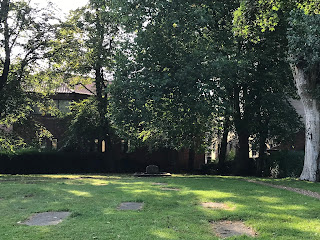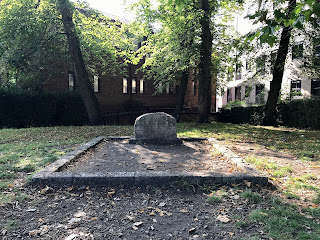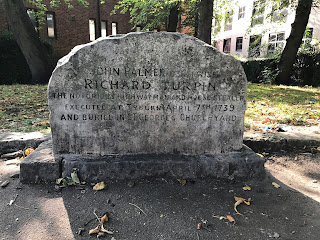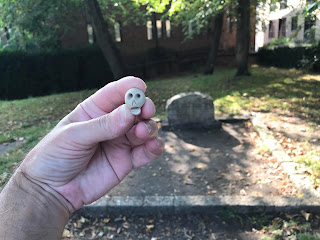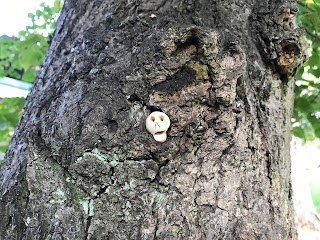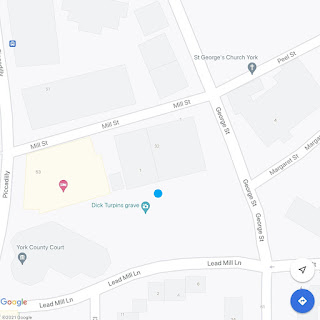I first discovered Dick Turpin’s grave many years ago on a damp, February evening. I think I was in York on some work related business and was staying in a nearby hotel. After a few beers I went outside for a sneaky cigarette and on walking around the corner of the hotel found myself in a small graveyard. Most of the stones were laid flat in the ground with the exception of one at the far end of the cemetery. I walked over to see which local worthy merited having the only standing tombstone and found that it marked the grave of the notorious highwayman Dick Turpin. All I knew of him was the legendary (and very untrue) story of his ride from London to York on his horse Black Bess, to enable him to have an alibi for a crime he had been involved in. I imagined him as a character much like Adam Ant in the video for his song ‘Stand and Deliver’, a handsome and slightly androgynous man, dressed in fancy clothes, a bit of makeup and being quite charming as he relieved rich travellers of their ill gotten money and valuables. A bit of a Robin Hood character. Unfortunately, as is usually the case, the truth does not live up to the legend.
Richard
Turpin was born in 1705 in Essex and was a butcher by trade. In the 1730s he became involved with a gang
of Essex poachers known as the Gregory Gang, probably by helping them sell on
and dispose of the deer they had hunted and killed. As the crimes of the gang diversified, Turpin
joined with them in a series of violent and brutal housebreakings and robberies. These crimes caused such an outrage that in 1735
the Duke of Newcastle offered a £50 reward (around £11,000 in today’s money) for
information leading to the capture of the culprits. Several members of the gang were caught, and they
quickly betrayed and named Turpin and the other gang members. Turpin and the remaining members of the gang went
on to commit several more robberies, but with most of them soon captured by the
authorities, Turpin fled and for a while kept a low profile.
In
1737 Turpin joined up with two other highwaymen and committed a series of
robberies around the Waltham Forest area.
After being involved in a fatal shooting, Turpin again fled, this time
to a hideaway in Epping Forest. There he
committed several more robberies. Then,
one day while he was out and about in the forest looking for someone suitable
to rob, he came across Thomas Morris.
Morris recognised Turpin and presented his blunderbuss at him with the
intention of capturing him and handing him over to the authorities. Turpin, however, did not particularly fancy
facing the law and the hangman yet, so he quickly dived behind an oak tree,
drew his guns and shot Morris dead.
Then, before he could escape the scene, Turpin heard others approaching,
drawn by the noise of the shooting. Unable
to flee, he hid himself in a Yew Tree and remained there for almost two days
while he waited for those searching for him to move on. Eventually, when all was quiet, he made his
getaway.
In
June 1737 a reward of £200 (around £44,000 in today’s money) was offered for
the capture of Turpin for the murder of Morris.
A pardon was also offered to any of his accomplices who could lead the
authorities to him. At this time a
description of Turpin was given describing him as being ‘…about thirty years of
age, by trade a butcher, about five feet nine inches high, of a brown
complexion, very much marked with the Small-Pox, his cheek bones broad, his
face thinner towards the bottom, his visage short, pretty upright, and broad
about the shoulders.’ So, not much like Adam Ant then.
After
carrying out a few more robberies in and around Epping Forest, Turpin,
obviously beginning to feel the heat, left the area and made his way up to Yorkshire.
In
Yorkshire Turpin masqueraded as a horse trader named John Palmer and stole
horses to sell them on. He made friends
with several of the locals and often went out hunting with them. One day, on returning from hunting, he
spotted his landlord’s game cock strutting around in the street next to his
lodgings. Being a bit of a psychotic
creep and a bully, Turpin thought it would be fun to shoot it, so drew his gun
and blew it away. One of the landlord’s
friends saw him do this and remonstrated with him. Turpin then threatened to shoot him too. The landlord, on being told of what had
happened, obtained a warrant, and had Turpin detained. Turpin then appeared before three Justices of
the Peace and was committed to the House of correction at Beverley. The Justices of the Peace were suspicious about
how Turpin had made his money and suspecting that it may have been through
criminal activity, they made enquiries about him. It was soon established that Turpin was
suspected of carrying out thefts of both horses and sheep. As horse theft was a capital crime that could
result in the death penalty it was decided to transfer Turpin to be held at the
more secure location of York Castle.
While
in prison there, Turpin wrote to his brother in law in Essex. However, he refused the letter, and it was returned
to the post office where James Smith, who had taught Turpin to read and write,
saw it. He recognised the handwriting and
travelled to York where he identified John Palmer as being none other than Dick
Turpin. For this Smith was given the £200
reward that had been advertised for the capture of Turpin.
On
the 22nd of March 1739 Turpin stood trial at York for the theft of
several horses. He was found guilty and sentenced
to death.
On
Saturday the 7th of April 1739 Turpin was taken in an open cart through
York to the place of execution at Knavesmire.
It was noted that he behaved with ‘amazing assurance’ and bowed to the
spectators gathering to watch him hang. As
he climbed the ladder to the gallows it was noticed that his right leg trembled,
and he stamped down to stop it. He then
spoke to the hangman for a few minutes and confessed to him that he was the
notorious highwayman Dick Turpin and recounted some of the robberies he had
been involved in. On finishing his chat
with the hangman, Turpin threw himself from the ladder. He then died after about five minutes and his
body was left to hang for several hours before being cut down.
Turpin’s
corpse was taken to a local inn at about three that afternoon and was buried
the next morning in St George’s Churchyard.
Shortly after being buried, it was reported that his body had been dug
up and stolen. There was a huge outcry
about this, and the body snatchers and Turpin’s corpse were soon found. Turpin’s body was quickly reburied, and this
time was covered in quicklime.
And
that would be the end of that, or so you’d think, but now there is some doubt
that the gravestone really does mark the grave of the notorious Dick
Turpin. It is thought that the stone, placed
at the grave a couple of hundred years after Turpin’s death, was put there more
as a tourist attraction and that Turpin would have been buried in an unmarked
grave. Whatever the truth is, I don’t
know, but I’ll take it as being the place where Dick Turpin is buried…probably.
I
left the Skulferatu that accompanied me on my wanders around York to the grave,
in the hollow of a tree overlooking the graveyard.
The
coordinates for the location of the Skulferatu are –
Latitude 53.954961
Longitude
-1.076049
I used the following sources for information on Dick Turpin –
Wikipedia – Dick Turpin
The Trial of the Notorious
Highwayman, Richard Turpin
By Thomas Kyll
Wikisource
- The Trial of the Notorious Highwayman Richard Turpin
Derby Mercury – Thursday, 30th
June 1737
The Newcastle Courant –
Saturday, April 21, 1739
The Yorkshire Post – Wednesday,
5th July 2017
Tourist information sign at
site
Values of rewards in today’s
money offered for capture of Turpin calculated using the bank of England’s
Inflation Calculator
Inflation
calculator | Bank of England
